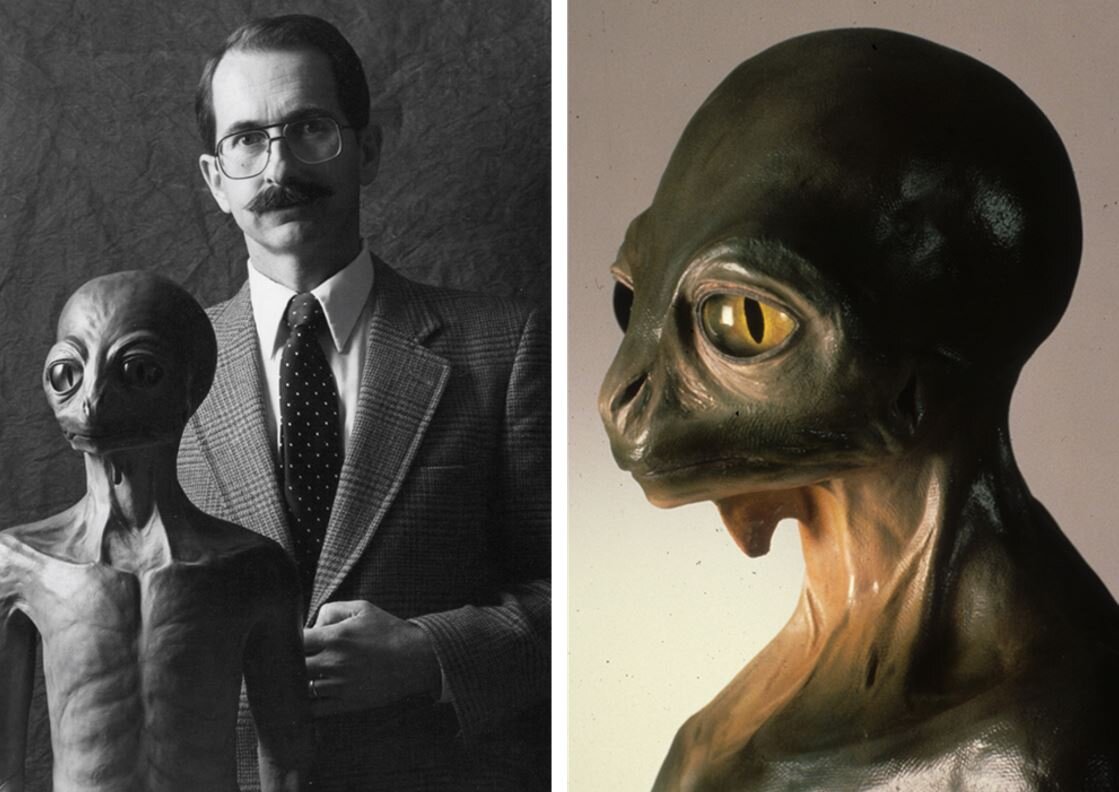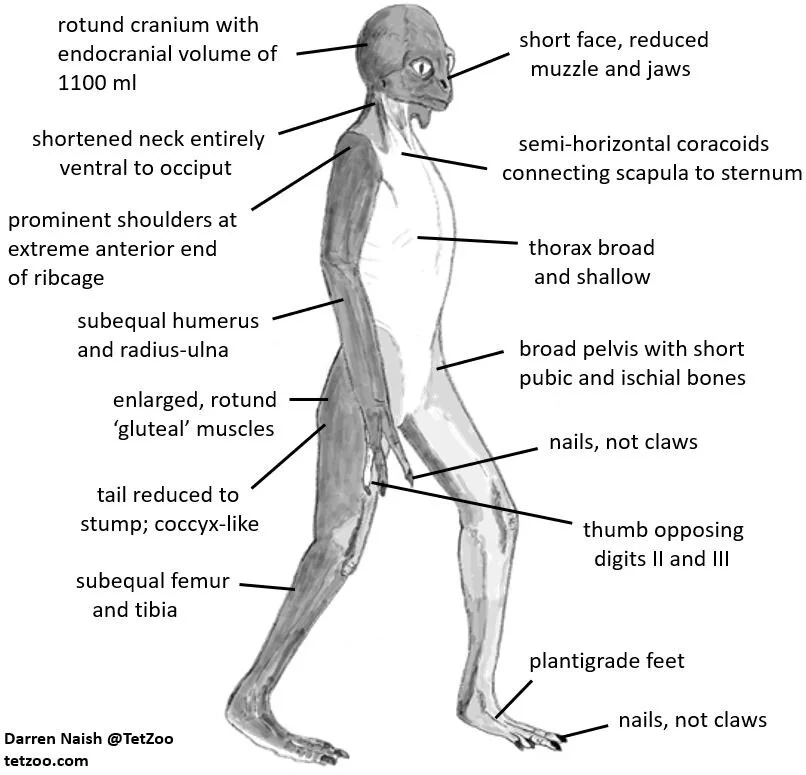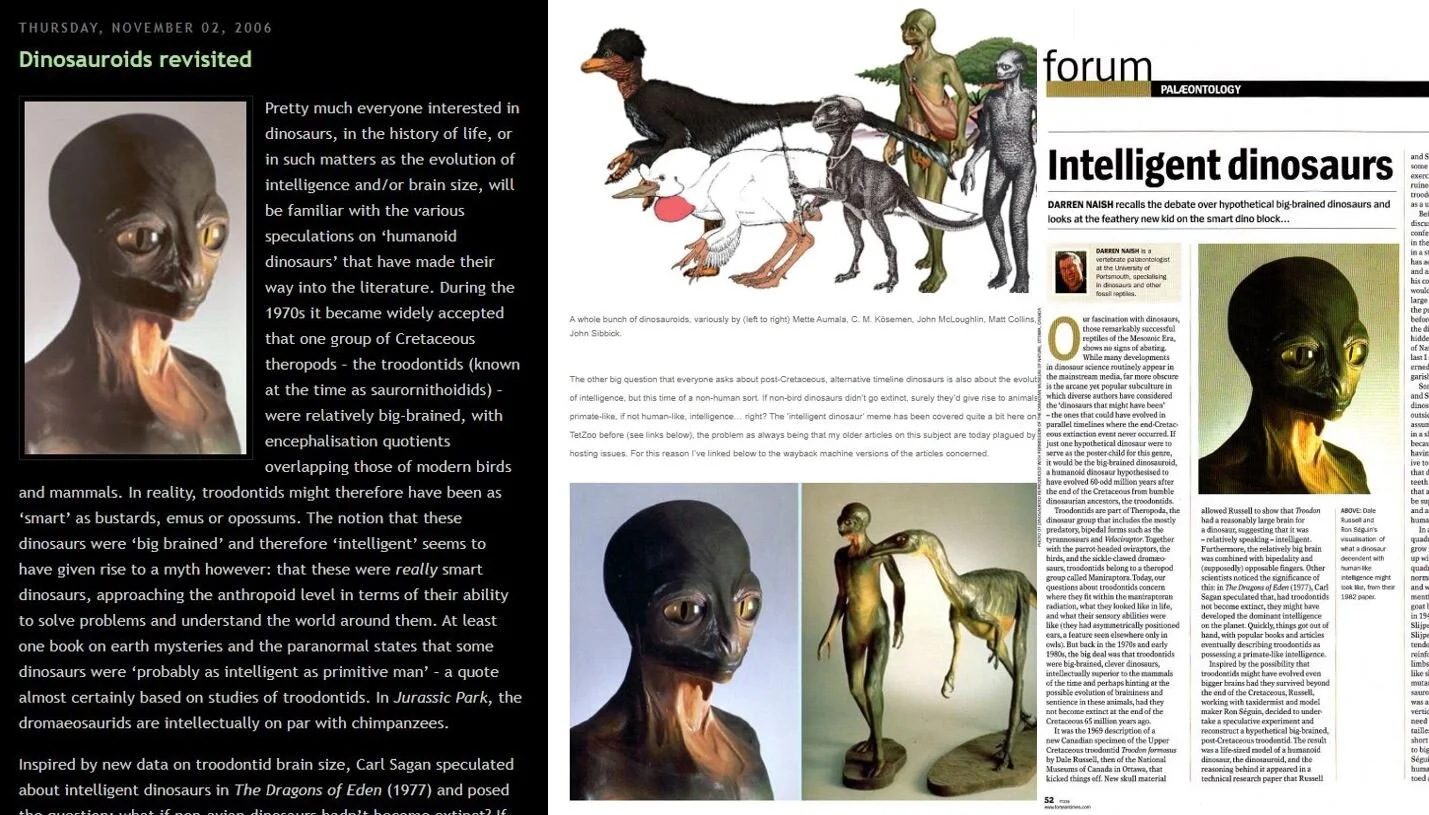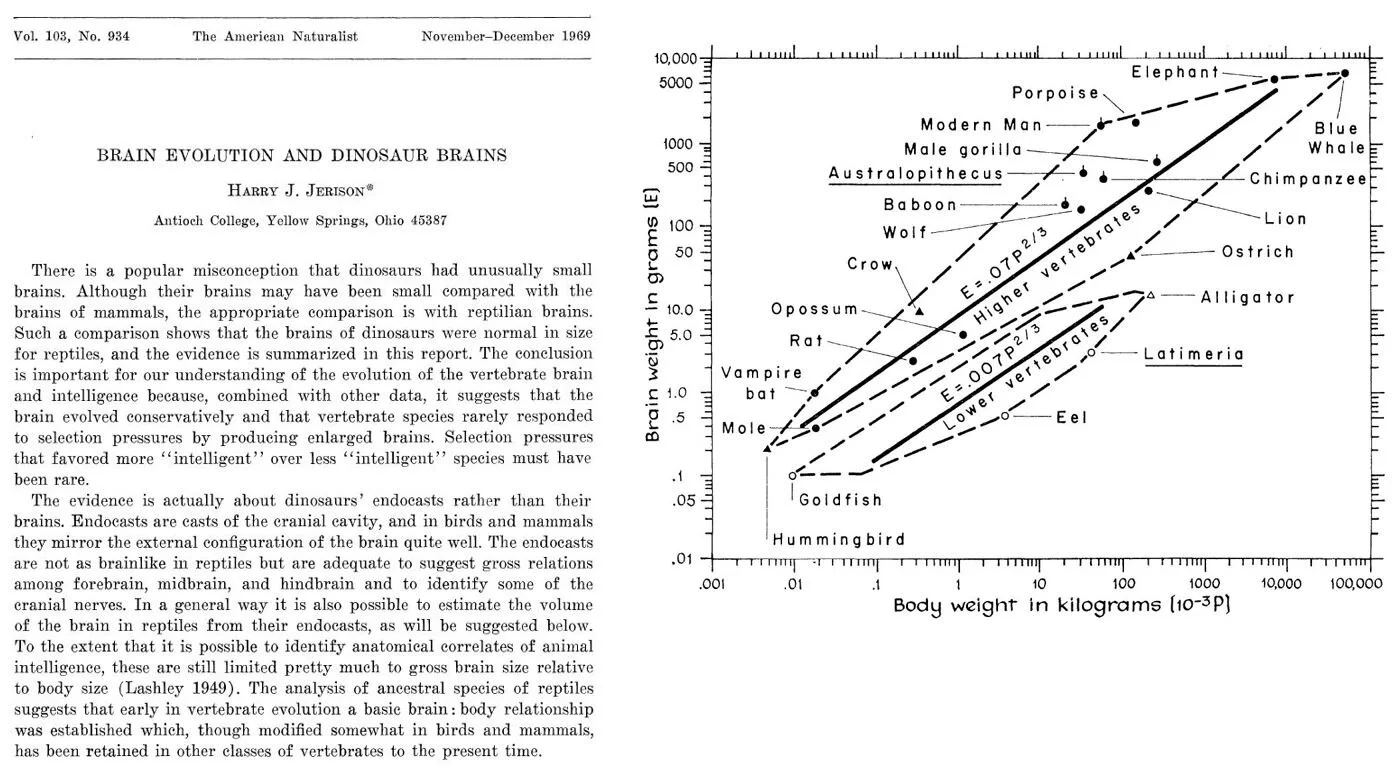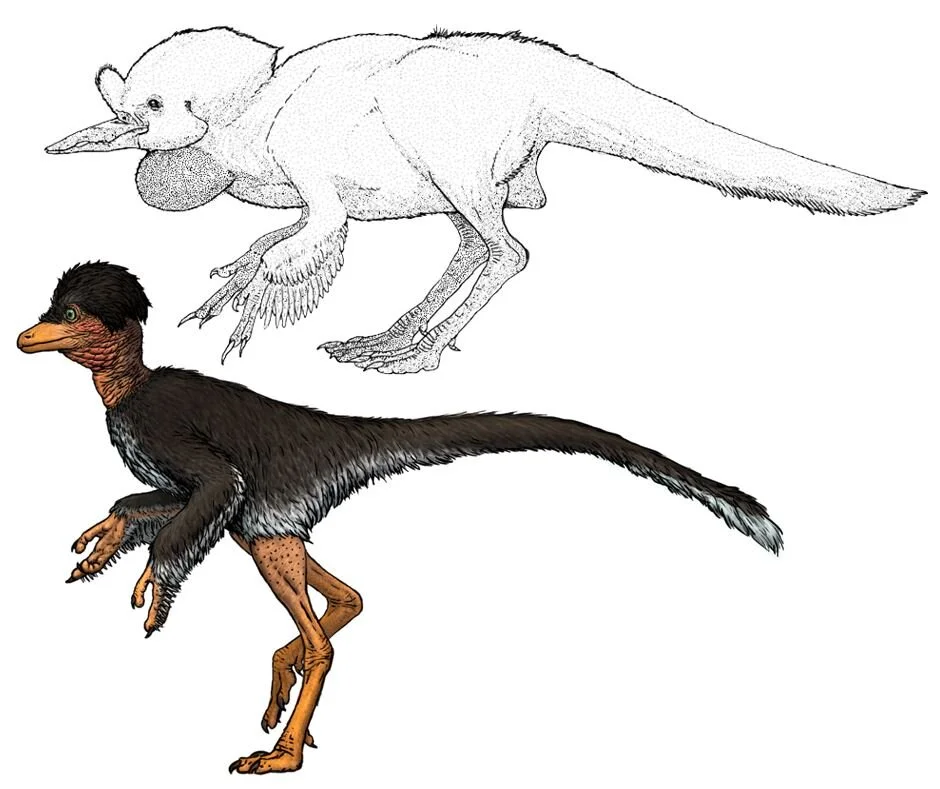If you’re at all familiar with Speculative Zoology – or with the history of speculative biology in general – you will of course be very much aware of the dinosauroid….
Caption: several images of the dinosauroid (like that shown at right) are quite familiar, but that’s not so for the picture at left. Dale Russell was a tall man, but even so the small stature of the dinosauroid is obvious, it standing 1.35 m tall. Images: © Canadian Museum of Nature.
….. an imaginary, human-shaped theropod invented during the early 1980s by palaeontologist Dale Russell and artist and model-maker Ron Séguin. The dinosauroid was first outed in print in 1982 (Russell & Séguin 1982) and a vast amount has been written about it. It has, in fact, been discussed and revisited here on several occasions since 2006 (when TetZoo first came into existence) [see links below].
Caption: at left, the cover page of Russell & Séguin (1982). At right, from l to r: Dale Russell, the dinosauroid during its construction, and Ron Séguin. Images: (c) Ron Séguin.
If you’re a regular reader of TetZoo, you’ll have heard several times previously what I and several other palaeontologists already think of the dinosauroid. Firstly, the entire premise (whereby troodontid theropods are imagined to have had the potential to evolve into humanoids) is inconsistent with what we might really ‘expect’ of hypothetical post-Cretaceous troodontids. Troodontids – had they survived and continued evolving – would have resembled bustards, big hawks or ground hornbills and were not in any way semi-human nor becoming so.
Secondly, the notion of the humanoid being an evolutionary inevitability is probably both biased and flawed and missing a key point, this being that the evolution of the humanoid is contingent on the fact that humans are anthropoid primates: animals that started their evolutionary history with the broad, shallow-chested bodies, plantigrade feet, opposable fingers, short faces and other features inherent to the humanoid bauplan.
Caption: human-like features of the dinosauroid reported by Russell and Séguin, superimposed on a dinosauroid illustration produced for my 2021 Dinopedia.
On December 21st 2019, Dr Dale Russell died, aged 82. Such was the value of his many published contributions and esteem with which he was held that plans for a special issue of Canadian Journal of Earth Sciences were very soon made. I’m pleased to say that I was invited to contribute a dinosauroid-themed article for this tribute issue. Keen to produce something novel (rather than re-hash the arguments given above, as I’ve already done a few times now: Naish 2008, 2021), I teamed up with literary scholar Will Tattersdill. Will has his own thoughts on the dinosauroid, has written an in-press article on the subject, and definitely brings a new approach to the table. I’m pleased to say that our collaboration proved fruitful, the result of which is our very recently published paper ‘Art, anatomy and the stars: Russell and Séguin’s dinosauroid’ (Naish & Tattersdill 2021). A version with final formatting has only just appeared online; the final, paginated version will appear at some point in the near future. Ask me if you want a pdf.
Caption: at left and middle, previous outings of the dinosauroid at TetZoo. At far right, part of my 2008 Fortean Times article (Naish 2008) on dinosauroids.
Two things make our paper different from previous contributions on the dinosauroid. One is that – thanks to kind co-operation from Jordan Mallon at the Canadian Museum of Nature – we had full access to Dale Russell’s correspondence. And two is that we corresponded extensively with Ron Séguin. Ron was extremely generous with his time and the material he owns, and provided us with a large amount of information not shared before. I should add that, some years in the past, I corresponded with Dr Russell too, albeit never on the dinosauroid.
The genesis of the dinosauroid. What, precisely, was the genesis of the dinosauroid? Russell’s writings on the evolution of intelligence and brain size, on dinosaurs and their evolution and extinction, and on the possible existence of intelligent aliens overlapped such that speculative thoughts on potential big-brained dinosaurs make the project seem like an inevitable outcome of his interests. It is in fact obvious from Russell’s correspondence, his published remarks, and the recollections of those that knew him that these matters were on his mind continually during the late 1970s and early 80s. The general impression I gained during research is that Russell was mostly using the dinosauroid to drive debate and interest in these things: the fact that the dinosauroid is meant to be a modified theropod dinosaur might, in fact, almost be irrelevant.
Caption: Dale Russell was extremely fond of Harry Jerison’s graphs on the relationship between brain size and body size and often shared them. This work has been superseded and is based on some questionable assumptions (in particular that all vertebrate groups might fit on one of either two best-fit lines).
Russell was, of course, struck by the brain size of some coelurosaurs and – apparently as early as 1965 – was very much aware of the possibility that some of these animals might have had the potential to evolve even greater encephalisation had conditions allowed (Psihoyos & Knoebber 1994, Naish & Tattersdill 2021).
Russell and Sagan. Essentially overlooked or unknown until now is that Russell corresponded extensively with Carl Sagan. In 1976, Sagan was busy writing The Dragons of Eden (Sagan 1977), and he’d heard from astrophysicist Melvin Ruderman about the existence of big-brained dinosaurs somehow relevant to thoughts on non-human intelligence. Sagan approached Russell for help and thus it is that The Dragons of Eden includes a few paragraphs on brainy coelurosaurs and the possibility that they might have evolved human-level intelligence had they persisted to the present (Sagan 1977, pp. 135-136).
Caption: science communicator and scientist extraordinaire Carl Sagan. At right, the famous Pale Blue Dot image, showing Earth as seen from Voyager 1 in 1994 when it was 6 billion kilometres from home, an image that Sagan encouraged NASA to take. Both images in public domain.
In letters of 1977, Russell and Sagan shared thoughts on the end-Cretaceous extinction event (Russell was interested in exploring the idea that a cosmic event like a supernova might have been the causative agent). Sagan also sent Russell some of the Viking photos of Mars during late 1976, a 1976 article he penned on the Loch Ness Monster, and a copy of The Dragons of Eden itself in June 1977 (Naish & Tattersdill 2021). Russell also asked Sagan his thoughts on “the creator as described in scripture”, a topic we’ll get to in a moment.
Caption: Sagan’s 1977 The Dragons of Eden, as approved by author of The Space Vampires! At right, the Saurornithoides image that appears in Sagan’s book. Sagan credited this image to Dale Russell’s 1969 paper on Stenonychosaurus. No such image appears there, so I’m not quite sure where it really came from.
While we can be confident that it was Russell’s thoughts on theropod intelligence and brain size that inspired Sagan’s comments in The Dragons of Eden, could things have worked in reverse: was Sagan inspirational to Russell? We feel that they likely helped give Russell an inspirational boost: “Sagan’s statements likely gave Russell the impetus he needed to begin the dinosauroid experiment” (Naish & Tattersdill 2021, p. 8 unpaginated).
Russell and SETI. Also relevant here is that Russell was frequently involved during the late 70s and early 80s in SETI (the Search for Extraterrestrial Intelligence programme). He exchanged letters with NASA staff on several occasions, wrote in 1979 (to NASA’s Mark Stull) that he was devoting his evenings to SETI-based research, and was a signatory on Sagan’s 1982 Science letter on the importance of SETI’s persistence (Sagan 1982).
Caption: I love that Mark Stull (the main focus of our attention, because of his correspondence with Russell) is so cheerfully acknowledging the act of photography, unlike everyone else here.
What does this have to do with the dinosauroid? Russell wrote several times that dinosauroid-like humanoids could have evolved in “some biospheres” (Naish & Tattersdill 2021, p. 8 unpaginated), and said more than once between 1979 and 1981 that he would be able to bring a hypothetical reconstruction of a big-brained dinosaur to SETI-themed meetings. Remember that all of this was happening a couple of years before the dinosauroid was brought to life in 3D form. I also think it’s important that, again, the dinosauroid was being used to promote ideas about intelligent aliens: it again makes me think that Russell’s focus wasn’t on speculative dinosaur evolution at all, but on promoting the idea of humanoid intelligences evolving elsewhere in the universe.
That which must not be discussed. I’m confident that another factor contributed to the construction of the dinosauroid, but it’s something more controversial than everything discussed so far and is also harder to establish with any degree of certainty. I think that Dale Russell’s specific personal views on the nature of the universe and the position of humans within it played a role in everything that happened.
We know from the recollections of his colleagues that Dale Russell was religious, with an active spiritual life committed to Catholicism. We also know from statements made by Robert Bakker and others who discussed religion with him that Russell was fond of the ideas of Jesuit priest and palaeontologist Teilhard de Chardin (Campagna 2001, p. 7, Noble 2016, p. 41). Chardin (1959) argued for a directionality in evolution, that humans represent a point close to (but not at) the pinnacle of evolution, and that a humanoid stage was inevitable for those organisms approaching evolution’s final stage. Add to this the fact that Russell stated in correspondence his idea that “the human form might be a natural target for selective pressures” (as Russell wrote to anthropologist Noel Boaz in August 1984), and his implication – made several times in interview – that humans (and, by extension, other humanoids) are not simply additional animals (Russell 1987, p. 130, Psihoyos & Knoebber 1994, p. 252). We’re talking here about what’s been called the ‘inevitable humanoid proposition’, a concept often linked both to religiosity and to an anthropocentric view of the universe.
Caption: whenever I think of Pierre Teilhard de Chardin and his book The Phenomenon of Man, I think of Bakker’s words “it was the first popular book … about evolution within the context of orthodox Christianity. Don’t try to read it. It’s impossible” (Campagna 2000, p. 7).
My personal opinion is that the dinosauroid was not, then, the honest experiment in speculative evolution that some authors have implied (e.g., Losos 2017; reviewed here at TetZoo). Instead, Russell had already decided that he wanted to showcase the possibility that human-shaped non-humans were ‘inevitable’, and that they might have a special place in the design of the universe.
A key point: it sure looks here like I’m reading between the lines. Speculating. Are my speculations better justified anywhere? In the final paragraphs of his very dense, 453-page 2009 Islands in the Cosmos: the Evolution of Life on Land, Russell (2009) states that there might be a “Reason” (yes, with capital R) which has arranged the order of things within time and the universe. The pages carry the implication that the universe can be regarded as part of a design, a design designed for humanoids. But that’s about it. Scientific writing tends not to allow an exploration of personal convictions or feelings, meaning that Dale Russell’s published works are essentially never specific on his religious views or gut instincts; they’re excluded from the narrative in a way that most of us would deem understandable.
Caption: Russell’s 2009 Islands in the Cosmos: the Evolution of Life on Land includes a few nods at the end to the idea of the universe being designed, but the words are obtuse and you can’t pin any specific agenda on what Russell says.
In a biographical case like this, however – where we aimed to discuss the project’s backstory with as much reference to personal motivations as possible – it’s ironic that we couldn’t include our thoughts and speculations on these more personal aspects. “Couldn’t”? Yes, couldn’t. We wrote a whole section on Dale Russell’s religiosity and its apparent link to the dinosauroid but were forced to remove it from the manuscript. The editorial team objected to its inclusion.
Caption: several scientists have expressed their dislike of the dinosauroid, among them David Raup (whose article ‘ETI without intelligence’ is included within Regis 1985, shown here) and Greg Paul.
Legacy: failure and success. A non-trivial part of the dinosauroid story is the community’s reaction and how this affected Russell personally. As is well known, the idea suffered “much friendly abuse” (to quote Greg Paul in Predatory Dinosaurs of the World), several dinosaur specialists using the arguments outlined at the start of this article. I’m not pretending to be original on those points: such experts as David Raup, Stephen J. Gould, Thomas R. Holtz, jr, John Hutchinson and Greg Paul made them years before I published anything on the dinosauroid. Russell was very much aware of these criticisms (Russell 1987, p. 127), something we saw reflected in his correspondence (Naish & Tattersdill 2021). It’s telling, however, that he never responded to them.
Furthermore, he had a dinosauroid-heavy section of his 1989 book An Odyssey in Time pared down (Russell 1989). This is unfortunate since it means that a unique and amazing piece of art produced specially by Ely Kish was excluded. We secured permission to reproduce it, in colour, in our paper (Naish & Tattersdill 2021). It shows a 1980s-era ‘Carl Sagan of dinosauroids’ explaining a piece of palaeoart, which itself depicts Paleolithic-grade dinosauroids (one of whom is producing cave art). Finally, Russell also positively avoided discussing the dinosauroid during the 1990s and stopped attending conferences (Naish & Tattersdill 2021). It might be argued that he took the response of his colleagues unusually personally, and I wonder if this is another indication that it was linked to his personal, spiritual views.
Caption: the dinosauroid has been discussed and depicted in a substantial number of articles and books; this montage shows just a few of these many appearances.
In case any of this creates the impression that the dinosauroid project might be considered a failure, it’s important to note that it should be considered the absolute opposite of this.
Russell’s plan – evident from correspondence even before his article with Ron Séguin was published – was to encourage discussion about the evolution of intelligence and the ‘inevitability’ (or otherwise) of humanoids. As is evident from the truly vast number of post-1982 media reports that covered the dinosauroid, the substantial critique the proposal received in the literature, and the dialogue it has encouraged on speculative evolution, hypothetical big-brained dinosaurs and imaginary post-Cretaceous dinosaurs in general, it has to be considered an extraordinary success (Naish & Tattersdill 2021). We basically end our paper on that point, and it’s clear – whatever you think of the dinosauroid and the inevitable humanoid proposition – that it has been and remains a foundational concept in speculations on evolution.
Caption: several post-Russell dinosauroids now exist, several ‘more realistic’ in terms of our understanding of maniraptoran anatomy and evolution. These images show C.M. Kösemen’s Avisapiens saurotheos (at top) and Mette Aumala’s Paranthropoharpax naishi. Images of both appear in Naish & Tattersdill (2021).
I’ll end things there. Here’s your reminder that a pdf of Naish & Tattersdill (2021) is available if you message me. Like an increasing number of my academic projects these days, the production of this paper is linked tightly to the history of this blog. It is, indeed, thanks to TetZoo that my views on the dinosauroid became findable online in the first place and it’s thanks to the funding I receive via patreon and other donors that I was able to cover financial charges associated with this work. Thanks to everyone who helped in some way, especially to Will for his co-authorship, to the Canadian Museum of Nature staff who assisted in procurement of the images, and to Jordan for co-operation and the initial invitation.
For previous TetZoo articles on the dinosauroid and other speculative dinosaurs, see…
Dinosauroids revisited, November 2006
Dinosauroid cave art discovered, March 2007
How intelligent dinosaurs conquered the world, March 2008
Belatedly, Nemoramjetia (= Avisapiens), November 2008
Richard Dawkins and the crappy ‘humanoid dinosaurs’ that just won’t die, November 2009
Dinosauroids revisited, revisited, October 2012
Speculative Zoology, a Discussion, July 2018
Alternative Timeline Dinosaurs, the View From 2019 (Part 1), December 2019
Alternative Timeline Dinosaurs, the View From 2019 (Part 2), December 2019
Alternative Timeline Dinosaurs, the View From 2019 (Part 3): the Dinosauroid and its Chums, December 2019
Refs - -
Campagna, T. 2001. Robert T. Bakker: interview with the maverick. The Dinosaur Society Quarterly Magazine 4 (2), 6-7.
Chardin, P. Teilhard de 1959. The Phenomenon of Man. Collins, London.
Losos, J. B. 2017. Improbable Destinies: How Predictable is Evolution? Penguin, London.
Naish, D. 2008. Intelligent dinosaurs. Fortean Times 239, 52-53.
Naish, D. 2021. Dinopedia. Princeton University Press.
Naish, D. & Tattersdill, W. 2021. Art, anatomy and the stars: Russell and Séguin’s dinosauroid. Canadian Journal of Earth Sciences https://doi.org/10.1139/cjes-2020-0172
Psihoyos, L. & Knoebber, J. 1994. Hunting Dinosaurs. Cassell, London.
Russell, D. A. & Séguin, R. 1982. Reconstruction of the small Cretaceous theropod Stenonychosaurus inequalis and a hypothetical dinosauroid. Syllogeus 37, 1-43.
Sagan, C. 1977. The Dragons of Eden. Random House, New York.
Sagan, C. 1982. Extraterrestrial intelligence: an international petition. Science 218, 426.

